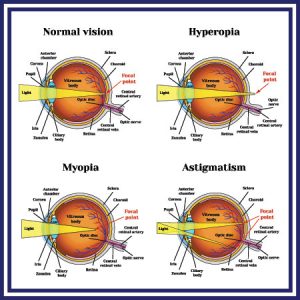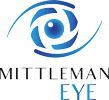Click here to resize type
LASIK
Millions of people move through life with poor vision, relying on prescription eyeglasses that fog and scratch or contact lenses that irritate their eyes. Laser-assisted in situ keratomileusis, or LASIK, is a laser refractive surgery that treats nearsightedness, farsightedness, and astigmatism so you no longer have to rely on corrective eyewear. Our experienced eye surgeons at Mittleman Eye in West Palm Beach and Jupiter can help you achieve visual freedom with LASIK.
What Is a Refractive Error?

Refractive errors happen when your eye fails to bend (or refract) light properly due to a misshapen cornea or rigid eye lens. Sharp vision relies on light rays to pass through the outer dome of your eye (cornea) and the inner eye lens and reach a point on the light-sensitive tissue lining the back of the eye (retina). The retina turns light into messages and sends the information through the optic nerve for your brain to translate into images. With refractive errors, the abnormal cornea or rigid lens prevents light from bending correctly, causing light to come to a point before or after the retina. The brain receives incorrect information, causing blurry vision.
LASIK corrects refractive errors caused by an irregularly shaped cornea — including nearsightedness (myopia), farsightedness (hyperopia), and astigmatism — by reshaping the tissue to refract light correctly. LASIK won’t correct lens issues, such as presbyopia, which happens with natural aging and causes blurry near vision. However, people with presbyopia may achieve better eyesight with refractive lens exchange.
Candidates for LASIK Eye Surgery
You must be at least 18 years old for LASIK, but most people will not qualify for laser vision correction until their early to mid-twenties when their vision stabilizes. You must wait until your vision prescription stays the same for at least one year to avoid under-correction. People interested in LASIK need refractive errors that fall within the parameters defined by the FDA, which include nearsightedness up to -12.00 D, farsightedness up to +6.00 D, and astigmatism up to 6.00 D.
LASIK manipulates the outer layer of corneal tissue (epithelium) and requires thick corneas to avoid unnecessary complications. Your eyes should be healthy with no history of dry eyes, eye infections, uncontrolled diabetes, or eye diseases. Pregnant or breastfeeding women should wait for LASIK because these body changes affect vision.
LASIK Procedure

Laser eye surgery with LASIK is an outpatient procedure, but you will need a friend or family member to drive you home. One of our eye surgeons administers numbing eye drops and positions an eyelid hold and suction ring to hold your eye in place while the laser reshapes your corneas. Most patients compare this to the pressure of a finger on the eyelid.
The LASIK procedure starts with creating an epithelial flap with a handheld microkeratome (surgical instrument with an oscillating blade) or a femtosecond laser. This paper-thin flap folds back to give our surgeon access to the cornea. They will direct you to look at a light to ensure your eyes don’t move, while an excimer laser uses pre-programmed measurements to reshape the cornea. You may hear a clicking sound as the laser works, and then the LASIK flap folds back into place and naturally re-attaches within minutes.
LASIK Recovery
Our eye surgeon will place a protective covering or shield over your eyes after the LASIK procedure. Your eyes may feel scratchy or burn for a few hours, but you will notice vision improvements right away. Mittleman Eye will provide detailed LASIK recovery instructions and prescriptions for special eye drops for healing and comfort. Follow these directions to ensure a smooth and quick recovery. You will need to wear an eye shield while you sleep for a few weeks to prevent eye rubbing.
LASIK recovery is fast; most people drive the next day and return to work within two to three days. You’ll visit one of our offices for follow-up the next day to test your vision and check your healing. Most LASIK patients are cleared to drive and work at this appointment.
Your vision may fluctuate for several weeks or months after LASIK, and you may experience dry eyes, glare, or halos around lights, but these concerns often go away within six to 12 months after LASIK.
According to the American Academy of Ophthalmology, 90% of LASIK patients end up with 20/20 to 20/40 vision without glasses or contact lenses.
Schedule Your LASIK Consultation at Mittleman Eye
If you’re ready for better vision without glasses or contact lenses, schedule a consultation at Mittleman Eye to see if LASIK is right for you. Request an appointment at our West Palm Beach or Jupiter location online or text or call (561) 500-2020.
















